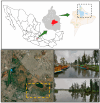Metagenomics Analysis of the Microbial Consortium in Samples from Lake Xochimilco, a World Cultural Heritage Site
- PMID: 40284671
- PMCID: PMC12029965
- DOI: 10.3390/microorganisms13040835
Metagenomics Analysis of the Microbial Consortium in Samples from Lake Xochimilco, a World Cultural Heritage Site
Abstract
Since ancient times, the community of Xochimilco in the south of Mexico City has provided vegetables for the entire city. Today, Lake Xochimilco is listed as a UNESCO World Heritage Site because it is the last remaining bastion of Aztec culture and preserves the extraordinary ecological landscape of chinampas, a system of arable islands that has endured for over 1000 years. Here, we report on the microbiological communities currently existing in the lake. This is relevant since the water irrigates crops on the islands, known as chinampas. To achieve this, samples from the lake were collected at two different sites, and metagenomics analysis of the 16S gene was conducted. The results indicate the presence of five dominant bacterial phyla: Actinobacteria (44.5%), Proteobacteria (22.5%), Firmicutes (13%), Bacteroidota (6%), and Chloroflexi (4.6%). The most abundant families were Micrococcaceae, Intrasporangiaceae, and Rhodobacteraceae. The results correlate with current anthropogenic activity, indicating a moderate problem associated with contamination. Our findings suggest that immediate actions and increased awareness are necessary to preserve this cultural and natural heritage site and to take steps to comply with Sustainable Development Goal 11 (Sustainable Cities and Communities). Furthermore, this is the first report to characterize microbial communities in the water of Lake Xochimilco using 16S rRNA gene sequencing.
Keywords: 16S RNA; SDG11; biotechnology; chinampa; cultural heritage; higher education; metagenomics; phylum; sustainability.
Conflict of interest statement
The authors declare no conflict of interest.
Figures




Similar articles
-
Metagenomic study of the microbiome and key geochemical potentials associated with architectural heritage sites: a case study of the Song Dynasty city wall in Shou County, China.Front Microbiol. 2024 Oct 25;15:1453430. doi: 10.3389/fmicb.2024.1453430. eCollection 2024. Front Microbiol. 2024. PMID: 39526141 Free PMC article.
-
The seduction of models. Chinampa agriculture in Mexico.Grassroots Dev. 1988;12(1):8-17. Grassroots Dev. 1988. PMID: 12342093
-
The microbial community characteristics of ancient painted sculptures in Maijishan Grottoes, China.PLoS One. 2017 Jul 5;12(7):e0179718. doi: 10.1371/journal.pone.0179718. eCollection 2017. PLoS One. 2017. PMID: 28678844 Free PMC article.
-
Microbiome and nitrate removal processes by microorganisms on the ancient Preah Vihear temple of Cambodia revealed by metagenomics and N-15 isotope analyses.Appl Microbiol Biotechnol. 2020 Nov;104(22):9823-9837. doi: 10.1007/s00253-020-10886-4. Epub 2020 Sep 19. Appl Microbiol Biotechnol. 2020. PMID: 32949277
-
Diversity and Coding Potential of the Microbiota in the Photic and Aphotic Zones of Tropical Man-Made Lake with Intensive Aquaculture Activities: a Case Study on Temengor Lake, Malaysia.Microb Ecol. 2019 Jul;78(1):20-32. doi: 10.1007/s00248-018-1283-0. Epub 2018 Nov 5. Microb Ecol. 2019. PMID: 30397794
References
-
- Ebel R. Chinampas: An Urban Farming Model of the Aztecs and a Potential Solution for Modern Megalopolis. Hortte. 2020;30:13–19. doi: 10.21273/HORTTECH04310-19. - DOI
-
- Onofre S.A. The floating gardens in México Xochimilco, world heritage risk site. City Time. 2005;1:5.
-
- Pérez-Belmont P., Alvarado J., Vázquez-Salvador N., Rodríguez E., Valiente E., Díaz J. Water quality monitoring in the Xochimilco peri-urban wetland: Experiences engaging in citizen science. Freshw. Sci. 2019;38:342–351. doi: 10.1086/703395. - DOI
Grants and funding
LinkOut - more resources
Full Text Sources

